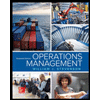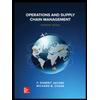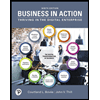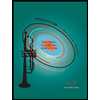2. Suppose that Alice, David, and Mike are working in a furniture factory, making chairs. The chair- making process consists of four activities: cutting and shaping the wood (5 min/chair), assembling the chair frame (5 min/chair), attaching the seat (10 min/chair), and finally, painting the chair (7 min/chair). Alice is responsible for the wood activity; David is responsible for the frames and painting activities and Mike is responsible for the seat activity. Each person can only do one activity at a time. The process flow diagram looks as below. Wood 5 min/chair Alice Frames 5 min/chair David Seats 10 min/chair Mike Painting 7 min/chair David a. Calculate the capacity of each resource. What is the bottleneck of the process and what is the capacity of the process? b. Calculate the utilization of each resource assuming that the process is operating at maximum capacity. c. Suppose that Alice is paid $10 per hour but only for the amount of time that she actually works, that David is paid $14 per hour but only for the amount of time that he actually works, and that Mike is paid $7 per hour but also only for the amount of time that he actually works. Suppose also that each chair sold brings a revenue of $130 and has raw materials cost of $60. Assuming that the chair factory is operating at its maximum capacity, what is the profit per hour after paying Alice David, and mike's salaries? d. If everyone could perform all four tasks and therefore the labor is pooled across all activities, what would be the capacity of the process? e. Suppose there is an additional activity after Painting where the chair needs to dry, which takes 10 minutes per chair. Assume there is infinite space for chairs to dry, and it does not require anyone to be there. How does the capacity of the process in steady state change due to this additional step?
2. Suppose that Alice, David, and Mike are working in a furniture factory, making chairs. The chair- making process consists of four activities: cutting and shaping the wood (5 min/chair), assembling the chair frame (5 min/chair), attaching the seat (10 min/chair), and finally, painting the chair (7 min/chair). Alice is responsible for the wood activity; David is responsible for the frames and painting activities and Mike is responsible for the seat activity. Each person can only do one activity at a time. The process flow diagram looks as below. Wood 5 min/chair Alice Frames 5 min/chair David Seats 10 min/chair Mike Painting 7 min/chair David a. Calculate the capacity of each resource. What is the bottleneck of the process and what is the capacity of the process? b. Calculate the utilization of each resource assuming that the process is operating at maximum capacity. c. Suppose that Alice is paid $10 per hour but only for the amount of time that she actually works, that David is paid $14 per hour but only for the amount of time that he actually works, and that Mike is paid $7 per hour but also only for the amount of time that he actually works. Suppose also that each chair sold brings a revenue of $130 and has raw materials cost of $60. Assuming that the chair factory is operating at its maximum capacity, what is the profit per hour after paying Alice David, and mike's salaries? d. If everyone could perform all four tasks and therefore the labor is pooled across all activities, what would be the capacity of the process? e. Suppose there is an additional activity after Painting where the chair needs to dry, which takes 10 minutes per chair. Assume there is infinite space for chairs to dry, and it does not require anyone to be there. How does the capacity of the process in steady state change due to this additional step?
Practical Management Science
6th Edition
ISBN:9781337406659
Author:WINSTON, Wayne L.
Publisher:WINSTON, Wayne L.
Chapter2: Introduction To Spreadsheet Modeling
Section: Chapter Questions
Problem 20P: Julie James is opening a lemonade stand. She believes the fixed cost per week of running the stand...
Related questions
Question
help me with parts b, c, d, e
this is all the information the question needs. my question got rejected because the previous expert did not know how to solve this

Transcribed Image Text:2. Suppose that Alice, David, and Mike are working in a furniture factory, making chairs. The chair-
making process consists of four activities: cutting and shaping the wood (5 min/chair),
assembling the chair frame (5 min/chair), attaching the seat (10 min/chair), and finally, painting
the chair (7 min/chair). Alice is responsible for the wood activity; David is responsible for the
frames and painting activities and Mike is responsible for the seat activity. Each person can only
do one activity at a time. The process flow diagram looks as below.
Wood
5 min/chair
Alice
Frames
5 min/chair
David
Seats
10 min/chair
Mike
Painting
7 min/chair
David
a. Calculate the capacity of each resource. What is the bottleneck of the process and what is the
capacity of the process?
b. Calculate the utilization of each resource assuming that the process is operating at maximum
capacity.
c. Suppose that Alice is paid $10 per hour but only for the amount of time that she actually
works, that David is paid $14 per hour but only for the amount of time that he actually works,
and that Mike is paid $7 per hour but also only for the amount of time that he actually works.
Suppose also that each chair sold brings a revenue of $130 and has raw materials cost of
$60. Assuming that the chair factory is operating at its maximum capacity, what is the profit
per hour after paying Alice David, and mike's salaries?
d. If everyone could perform all four tasks and therefore the labor is pooled across all activities,
what would be the capacity of the process?
e. Suppose there is an additional activity after Painting where the chair needs to dry, which
takes 10 minutes per chair. Assume there is infinite space for chairs to dry, and it does not
require anyone to be there. How does the capacity of the process in steady state change due
to this additional step?
Expert Solution
This question has been solved!
Explore an expertly crafted, step-by-step solution for a thorough understanding of key concepts.
This is a popular solution!
Trending now
This is a popular solution!
Step by step
Solved in 5 steps with 10 images

Recommended textbooks for you

Practical Management Science
Operations Management
ISBN:
9781337406659
Author:
WINSTON, Wayne L.
Publisher:
Cengage,

Operations Management
Operations Management
ISBN:
9781259667473
Author:
William J Stevenson
Publisher:
McGraw-Hill Education

Operations and Supply Chain Management (Mcgraw-hi…
Operations Management
ISBN:
9781259666100
Author:
F. Robert Jacobs, Richard B Chase
Publisher:
McGraw-Hill Education

Practical Management Science
Operations Management
ISBN:
9781337406659
Author:
WINSTON, Wayne L.
Publisher:
Cengage,

Operations Management
Operations Management
ISBN:
9781259667473
Author:
William J Stevenson
Publisher:
McGraw-Hill Education

Operations and Supply Chain Management (Mcgraw-hi…
Operations Management
ISBN:
9781259666100
Author:
F. Robert Jacobs, Richard B Chase
Publisher:
McGraw-Hill Education


Purchasing and Supply Chain Management
Operations Management
ISBN:
9781285869681
Author:
Robert M. Monczka, Robert B. Handfield, Larry C. Giunipero, James L. Patterson
Publisher:
Cengage Learning

Production and Operations Analysis, Seventh Editi…
Operations Management
ISBN:
9781478623069
Author:
Steven Nahmias, Tava Lennon Olsen
Publisher:
Waveland Press, Inc.